
| Bad Astronomy |
|
|
|
BA Blog
|
|
Q & BA
|
|
Bulletin Board
|
| Media |
|
|
|
Bitesize Astronomy
|
|
Bad Astro Store
|
|
Mad Science
|
|
Fun Stuff
|
| Site Info |
|
|
|
Links
|
| RELATED SITES |
| - Universe Today |
| - APOD |
| - The Nine Planets |
| - Mystery Investigators |
| - Slacker Astronomy |
| - Skepticality |
Buy My Stuff

Keep Bad Astronomy close to your heart, and help make me
filthy rich. Hey, it's either this or one of those really
irritating PayPal donation buttons here.
James McCanney's Nonsense
Miscellaneous Wrongnesses From McCanney
-
Comets emit X-rays, indicating they are not cold
-
Comet orbits circularize due to "tail drag"
-
"Tail drag" changed the orbit of
comet Hale-Bopp in 1996
-
Meteorites formed under pressure
-
The Sun's energy is not produced in its core, but
on its surface.
-
Hurricane production is tied in with the
"solar capacitor".
- The Apollo Moon Landings were faked.
McCanney claims in that book (on page 1!) that he predicted that
comets would give off
X-rays, and also that the side of the comet facing the Sun would be
the source of these X-rays. This has to do with his claim that
comets are plasma balls, electrically coupled with the Sun.
Amazingly, years later, it was found that not only do comets give off X-rays,
but they comes from the sunward side! Could McCanney have been right?
Nope. Well, his prediction was correct, but for the wrong reason. For a
prediction to be counted as a success, it has to be exclusive; that is, no
other theory could account for it. The problem is, there are plenty of
ways a comet could give off X-rays, even though it's cold. For
one, comets get smacked by the high-energy particles from the Sun's solar wind.
Ice, when hit like that, fluoresces; that is, gives off light. At
those energies, the light given off is in the form of X-rays. So naturally,
the part of the comet facing the Sun is where the X-rays come from.
McCanney is very derisive in his book about this. He says:
"Let's get serious... x-rays coming from a docile little snow ball?"
But think about it: when you go to the dentist, she isn't heating
the X-ray machine to a million degrees to get it to give off X-rays!
Those machines work by accelerating electrons to high speeds and
slamming them into metals. When the electrons hit the metal, they slow down
and emit X-rays in the process. So there are other processes which
generate X-rays besides temperature, despite what he is saying there.
Ironically, his own process is not thermal either, so why is he so
derisive of cold comets giving off X-rays? Oh yeah: it's because he's wrong.
This is another key part of his theory: since planets orbit the Sun in
fairly circular orbits, and comets tend to orbit in extremely elongated
ellipses, there must be some method to change a comet orbit into
a circle, since he says comets form planets.
To accomplish this he invents a force called "tail drag",
and goes through many gyrations to demonstrate it. However, I don't
need to go into any details debunking his details,
because as I already showed, the tail of a comet is from stuff coming
off the nucleus, not stuff coming in. Once the particle
leaves the nucleus and becomes part of the tail, it cannot affect the
nucleus. So there is no way his tail drag idea can work, because
his other ideas about comet tails are so wrong.
Not that this has stopped him from making silly claims using
this silly idea...
Hale-Bopp was a magnificent comet that became easy to see with the unaided
eye back in 1997. It was one of the most well-studied comets of all time.
It underwent something a little unusual, though: its orbital shape changed!
McCanney, of course, has an "explanation" of this:
tail drag (explained in the section above).
From McCanney's book "Planet-X, Comets & Earth Changes", page 52:
Here, McCanney is being incredibly deceptive. The only
thing he says that's correct in that statement is that Hale-Bopp's orbit
did in fact change. But he is very misleading in the way he
says it. First, no credible
scientist claims that jets (literally, jets of matter
emitted from the comet as solid ice
warms up and turns to gas,
acting like a little rocket) are what reduced Hale-Bopp's orbit. He might
as well say the theory of genetics cannot explain the change either!
They simply
have nothing to do with each other.
Second, it had nothing to do with its passing the Sun. In fact, the change
occurred long before it was anywhere near the Sun, when it was
still way out in the solar system.
What did happen is
that in April 1996, the comet passed less than 72 million miles from Jupiter.
That may sound like a long way, but Jupiter is a really
massive planet. The long reach of mighty Jupiter's gravity is what bent
Hale-Bopp's orbit, not any magical tail drag as claimed by McCanney.
News flash! McCanney gets something right!
Too bad it's for the wrong reason.
On his internet broadcast on several ocassions (for example, on July 1, 2004),
he has claimed that mainstream science is wrong about comets because
the structure of meteorites clearly indicates they were formed under pressure.
But then he says this is all according to his theories. However (hold
on to your hats!) he is quite wrong, in both cases.
The huge comet Hale-Bopp had its orbit reduced
from 4200 years to 2650 years in one passage of the Sun. The dirty
snowball "jetting concept" could
not account for this amazing change in orbit.
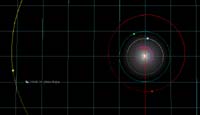 I found this out pretty easily, by doing something most pseudoscientists
never do: I asked someone. I posted the question to the
Minor Planets Mailing List, which is a mailing list comprised of
people who actually go out and do real astronomy (as opposed to
people like McCanney, who just make stuff up about it). I received a dozen
emails within minutes (!) letting me know what happened to Hale-Bopp
back in 1996. I then used some software to plot where Hale-Bopp was in
1996, and the answer was pretty clear: getting so close to Jupiter
bent the orbit of the comet, changing the period from more than 4000
years to less than 3000. Simple as that. McCanney is wrong again.
I found this out pretty easily, by doing something most pseudoscientists
never do: I asked someone. I posted the question to the
Minor Planets Mailing List, which is a mailing list comprised of
people who actually go out and do real astronomy (as opposed to
people like McCanney, who just make stuff up about it). I received a dozen
emails within minutes (!) letting me know what happened to Hale-Bopp
back in 1996. I then used some software to plot where Hale-Bopp was in
1996, and the answer was pretty clear: getting so close to Jupiter
bent the orbit of the comet, changing the period from more than 4000
years to less than 3000. Simple as that. McCanney is wrong again.
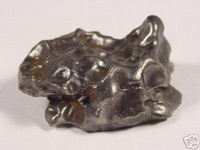
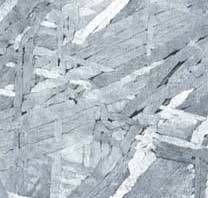
So McCanney is right! But wait! Is he really?
Nope. He is trying to say that meteorites come from comets. However, the vast majority of meteorites that hit the Earth are not from comets, because comet material is too fragile; it burns up completely. Look at meteor showers; those are due to material coming from comets, and those meteors never make it all the way to the ground. The vast majority of meteorites come from asteroids, not comets.
So he's right that meteorites formed under pressure (inside the core of
an asteroid), but he's completely wrong in saying this fits with his theory.
Here is one of those claims that when I read it, I actually said,
out loud, "Huh?" This claim is so weird, so out there, that
it's almost Hoaglandian in its scope.
According to the standard models of the Sun, the heat and pressure in
the Sun is so great that in the core, hydrogen atoms (really just their
nuclei) are smashed together. It's a complicated process, but the end
result is that they fuse together, forming a helium nucleus. This is
called nuclear fusion. In the process, a little bit
of heat is let out. But it happens so much in the Sun's core that
the total heat generated is enormous! Enough to heat
the core to 15 million Celsius, and produce the vast energy of
our nearest star.
But not according to McCanney. He claims in his book (in many places;
page 69 as an example) that there is fusion, but it happens
on the surface of the Sun. This is in part what creates
his so-called "solar capacitor" (an idea I already
trashed here). In fact, again on page 69, he
says this is what solves the long-standing "neutrino problem".
He also claims the Sun gets cooler as you go deeper, not hotter
as you'd expect in the standard model.
Let's look at that neutrino
problem. Basically, the equations of nuclear fusion
in the Sun predict that a subatomic particle called a neutrino
should be created. They are hard to detect, but when the technology finally
caught up with theory, only 1/3rd the number of expected neutrinos
were found. Where were the other 2/3rd of the neutrinos?
Hence the problem, which for years was quite a headache for astronomers.
According to McCanney (again, page 69) the lack of neutrinos was because
the fusion was happening on the Sun's surface. Since the Sun's surface isn't
nearly as hot as the core, the fusion must be happening much slower
than predicted (in the same way, I suppose, that one match produces
less heat than three will).
But there's a problem. Well, for McCanney, at least.
Recently, the
neutrino problem was solved. According to theory, there are three types
of neutrinos. What if we were only detecting one kind? Sure enough,
once again when the technology caught up, it was determined that this
is exactly what was happening! The kind of neutrino created in the solar
furnace was created in numbers as predicted, but on route to the
Earth changed their "flavor". Since we could only detect
the one kind, we didn't see the other two kinds, and the number was
only 1/3rd that of the original prediction. This problem
is now solved (and I suspect it may earn someone a Nobel Prize
someday too).
So McCanney is wrong yet again. And it gets worse for him, too.
This technique has been very successful. So successful, in fact, that
scientists have been able to map out the far side of the Sun!
And when the far side rotates into view, they have been able to confirm their
results, and therefore their method. In other words, this technique works.
However, the technique means that the standard model of the solar interior
must be correct (which in turn means the Sun does get hotter
as you go deeper, not cooler as McCanney claims).
So, in fact,
we understand the structure of the Sun pretty well.
And, too bad for McCanney, fusion occurs in the core, not the surface.
McCanney is wrong again.
Part of McCanney's theory states that electricity flows
like a circuit in the solar system.
I've already shown this to be completely wrong.
But on page 69 of his book, he says that the flow of electricity
occurs
"... in the direction from the Sun where Earth would be in the
month of August, the month of maximum auroras and
hurricane activity" (emphasis mine).
I am not exactly sure what he means by this, because it makes no sense.
But he goes on for many pages thereafter saying that hurricane activity
is tied to his theory.
The standard theory of hurricanes is that water is warmed up
in the summer. It heats the air, and, coupled with the Earth's rotation,
creates cyclones.
Which theory is correct? If you said McCanney's, then please read the
name of my website ten times out loud.
Both theories make a prediction. McCanney's predicts hurricane activity
peaks in the summer. Standard theory does too... for local
summer. See where I'm going with this? McCanney would predict hurricanes
peak only in August, because the force behind
hurricanes is tied with the
Sun, and not the seasons. That is summer, all right...
in the northern hemisphere. But summer in the southern hemisphere
is opposite the northern! So the prediction is clear: southern hurricanes
(technically, typhoons)
should peak in August, too. The standard model says they should peak
is austral summer, in February or so.
McCanney is wrong again.
Just to head him off at the pass, too, I predict he'll
be saying that this year should have a larger than average
number of hurricanes due to the influence of Planet X.
But,
the folks at NOAA have predicted the same thing based on
past hurricane trends. Needless to say, they don't use Planet X in their
predictive method. So his claiming this is meaningless.
Since 1995,
we've been in a period of above-average activity anyway.
Oh, and one more thing: he said that auroral activity peaks in August.
Bzzzzzt. Actually,
the most activity is in October, February, and March.
Surprise! McCanney is wrong again.
I had to save this one for last. I mean, c'mon! Even McCanney
couldn't claim this!
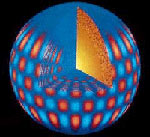 Geologists study earthquakes because they can tell us about the
interior of the Earth by the way the waves travel. The same is
true for the Sun. A new discipline, called helioseismology,
studies the effect of waves as they travel through the Sun.
By doing this, solar astronomers have been able to map out the
interior of the Sun in the same way that seismologists have mapped
out the interior of the earth.
Geologists study earthquakes because they can tell us about the
interior of the Earth by the way the waves travel. The same is
true for the Sun. A new discipline, called helioseismology,
studies the effect of waves as they travel through the Sun.
By doing this, solar astronomers have been able to map out the
interior of the Sun in the same way that seismologists have mapped
out the interior of the earth.
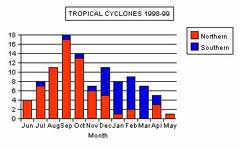 Guess what? The peak of the number of cyclones in the
southern hemisphere is in February, six months offset
from the northern peak. The plot here shows just that;
red is northern hurricanes, and blue southern. You can clearly
see that August has a minimal number of cyclones in the south,
the opposite of what McCanney's theory predicts (clicking on that
image will take you to a great page about hurricanes and typhoons).
Guess what? The peak of the number of cyclones in the
southern hemisphere is in February, six months offset
from the northern peak. The plot here shows just that;
red is northern hurricanes, and blue southern. You can clearly
see that August has a minimal number of cyclones in the south,
the opposite of what McCanney's theory predicts (clicking on that
image will take you to a great page about hurricanes and typhoons).
©2008 Phil Plait. All Rights Reserved.
|
|